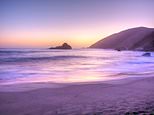
If you’ve ever been to Bermuda or the Bahamas, you’ve probably seen the famous pink-sand beaches, made up of the shells of tiny sea creatures.
Or if you’ve braved the arctic cool of Iceland, you may have seen one of the many black sand beaches formed from volcanic activity.
But, while pink and black sand beaches are relatively common, purple sand is much harder to find.
And the conditions for a purple sand beach are highly specific and uncommon, making them a unique natural phenomenon.
To see it for yourself, you’ll need to travel across the pond as most purple sand beaches are found in North America, such as Pfeiffer Beach in California.
Purple sands are formed when purple minerals, such as garnet, are washed down to beaches from nearby hills or cliffs and accumulate with other sands.
The purple colour of sand comes from high concentrations of specific minerals that are more resistant to erosion, such as garnet.
These mineral-rich rocks are found in the surrounding geology and are eroded, with rain washing the mineral grains down toward the ocean or lakes.
While pink and black sand beaches are relatively common – though still an unusual sight to behold – purple sand is much harder to find
Pfeiffer Beach in California (pictured) is famous for its purple sand
Tan sand, which can be found across most sandy beaches in the UK, is primarily composed of quartz.
Purple sand’s distinct hue comes from the garnet’s mineral composition, specifically almandine-pyrope garnet.
The sand on these beaches can come in different shades, from lavender to magenta, due to the specific way the garnet was formed, and whether the sand is mixed with other minerals.
In Saskatchewan, Canada, there is a coastal spot called Purple Sands Beach, in Candle Lake Provincial Park, where the sand can appear a range of colours.
The sand’s vibrant hues are caused by garnet carried by glaciers from the Canadian Shield and deposited in the lake’s shallow areas.
The colours are often more visible after strong winds or large waves churn the sand, and the amount of coloured sand can fluctuate with the changing seasons.
These minerals may have been picked up by huge sheets of ice during the last Ice Age and eventually deposited on the lake shores, according to Reader’s Digest.
It is normally safe to swim at beaches with purple sand as the garnet isn’t harmful.
Purple sand’s distinct hue comes from the garnet’s mineral composition, specifically almandine-pyrope garnet. Keyhole Rock at Pfeiffer Beach is pictured
Unfortunately, there aren’t any purple sand beaches in the UK.
However, some UK beaches feature purple-coloured sandstone, like Caerfai Bay, which is mined for building stone.
It comes after we revealed inside the Mediterranean island where all you can do is ‘sunbathe and swim’.
Spain’s smallest permanently inhabited island, Nueva Tabarca, stretches just 1,800 metres.
The flat, tiny island spans only 400 meters at its widest point – and around 50 people live here year-round.
Share or comment on this article:
The rare phenomenon that makes some beaches have purple sand
Source link
CHECK OUT: Top Travel Destinations
READ MORE: Travel News



